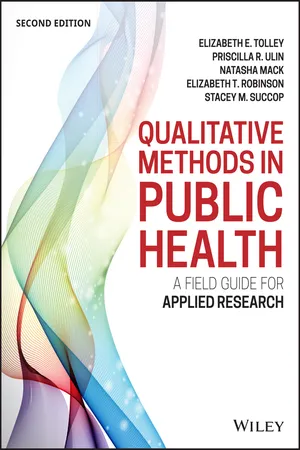
Qualitative Methods in Public Health
A Field Guide for Applied Research
- English
- ePUB (mobile friendly)
- Available on iOS & Android
Qualitative Methods in Public Health
A Field Guide for Applied Research
About this book
Qualitative Methods in Public Health: A Field Guide for Applied Research, 2nd Edition provides a practical orientation to conducting effective qualitative research in the public health sphere. With thorough examination and simple explanations, this book guides you through the logic and workflow of qualitative approaches, with step-by-step guidance on every phase of the research. Students learn how to identify and make use of theoretical frameworks to guide your study, design the study to answer specific questions, and achieve their research goals.
Data collection, analysis, and interpretation are given close attention as the backbone of a successful study, and expert insight on reporting and dissemination helps you get your work noticed. This second edition features new examples from global health, including case studies specifically illustrating study design, web and mobile technologies, mixed methods, and new innovations in information dissemination. Pedagogical tools have been added to help enhance your understanding of research design and implementation, and extensive appendices show you how these concepts work in practice.
Qualitative research is a powerful tool for public health, but it's very easy to get it wrong. Careful study design and data management are critical, and it's important to resist drawing conclusions that the data cannot support. This book shows you how to conduct high-quality qualitative research that stands up to review.
Frequently asked questions
- Essential is ideal for learners and professionals who enjoy exploring a wide range of subjects. Access the Essential Library with 800,000+ trusted titles and best-sellers across business, personal growth, and the humanities. Includes unlimited reading time and Standard Read Aloud voice.
- Complete: Perfect for advanced learners and researchers needing full, unrestricted access. Unlock 1.4M+ books across hundreds of subjects, including academic and specialized titles. The Complete Plan also includes advanced features like Premium Read Aloud and Research Assistant.
Please note we cannot support devices running on iOS 13 and Android 7 or earlier. Learn more about using the app.
Information
Chapter 1
Invitation to Explore
Objectives:
- To introduce researchers to qualitative methods in public health research, including those whose training and experience may be predominantly in quantitative methods
- To describe the basic characteristics of a qualitative research approach
- To show how qualitative methods can shed new light on complex questions in public health
- To highlight the aspects of qualitative research methodology presented in this book, including content new to this second edition
Our Purpose
What Is Qualitative Research?
Box 1.1: Characteristics of Qualitative Research
- Explores and discovers
- Seeks depth of understanding
- Views social phenomena holistically
- Provides insight into the meanings of decisions and actions
- Asks why, how, and under what circumstance things occur
- Uses interpretive and other open-ended methods
- Is iterative rather than fixed
- Is emergent rather than prestructured
- Involves respondents as active participants rather than as subjects
- Defines the investigator as an instrument in the research process
- Qualitative research is systematic discovery. Its purpose is to generate knowledge of social events and processes by understanding what they mean to people, exploring and documenting how people interact with each other and how they interpret and interact with the world around them. It also seeks to elucidate patterns of shared understanding and variability in those patterns.
- Qualitative researchers value natural settings where the researcher can better understand people's lived experiences. The natural context of people's lives is a critical component of qualitative design because it influences the perspectives, experiences, and actions of participants in the study. It is the interpersonal and sociocultural fabric that shapes meanings and actions. Many problems central to public health research and practice are deeply embedded in their cultural contexts. People in communities confront decisions and challenges that are conditioned by membership in multiple social groups: whether to vaccinate children, how to prevent obesity, where to go for help in times of illness, and how to give young people the skills and confidence they will need for healthy adulthood. Contradictions and competing priorities can make many seemingly commonplace decisions difficult: Spend money on prescription drugs, or save for retirement? Protect...
Table of contents
- Cover
- Title Page
- Copyright
- Table of Contents
- Dedication
- List of Figures, Tables, and Boxes
- List of Case Studies
- Foreword
- Acknowledgments
- About the Authors
- Chapter 1: Invitation to Explore
- Chapter 2: The Language and Logic of Qualitative Research
- Chapter 3: Designing the Study
- Chapter 4: Collecting Qualitative Data: The Science and the Art
- Chapter 5: Logistics in the Field
- Chapter 6: Qualitative Data Analysis
- Chapter 7: Disseminating Qualitative Research
- Chapter 8: Putting It Into Words: Reporting Qualitative Research Results in Scientific Journals and Reports
- Appendix 1: Case Studies
- Appendix 2: Examples of Oral Consent Forms
- Appendix 3: Participant Observation Notes
- Appendix 4: Topic Guides With Pictures
- Appendix 5: Sample Interviewer Training Program Agendas and Training Schedules
- Appendix 6: Sample Budget Categories for Planning Qualitative Data Collection
- Appendix 7: Coding Summary Report
- Appendix 8: Example of Data Analysis Memo
- Appendix 9: Making Study Findings Accessible to Other Researchers
- Appendix 10: Dissemination materials for community stakeholders
- Appendix 11: Sample Briefs to Share Qualitative Study Findings with Policy Audiences
- Appendix 12: Sample Dissemination Strategy for Advocacy
- Appendix 13: Where to Publish
- Appendix 14: Who Is an Author?
- Index
- End User License Agreement